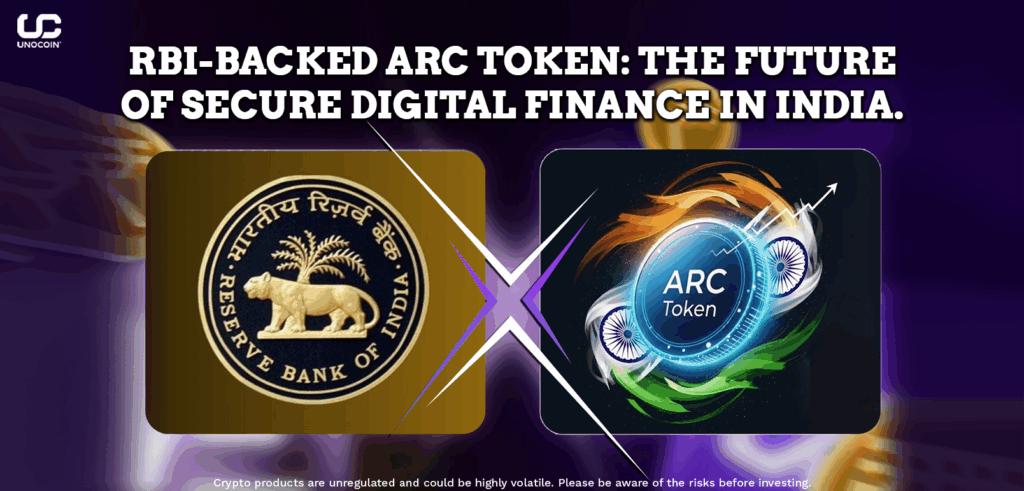India is entering a new chapter in digital finance.
A rupee-backed ARC stablecoin, scheduled for public rollout in Q1 2026, is poised to become a major milestone in how money moves, settles, and grows within India’s financial ecosystem. Built in collaboration with Polygon and Anq, this new system represents one of the most ambitious real-world integrations of regulated digital assets anywhere in the world.
Unlike open crypto projects, ARC is designed to run within India’s financial sovereignty, aligning with frameworks from the Reserve Bank of India (RBI) and operating alongside the Digital Rupee (CBDC).
This could fundamentally reshape Indian payments, remittances, settlements, and institutional digital finance.
What Exactly Is ARC?
ARC is a fully rupee-backed stablecoin, built for:
- Banks
- FinTech platforms
- Enterprises
- Regulated financial institutions
It functions as a programmable, regulated digital asset that can settle transactions in real time, across multiple blockchain networks, with full transparency and KYC control.
The goal is simple:
“Digital money that moves at the speed of crypto — but with the safety, traceability, and oversight of the Indian financial system.”
Why Is ARC a Big Deal for India?
🔹 Protecting India’s Monetary Sovereignty
Most stablecoins today (USDT, USDC, etc.) are backed by the US dollar, meaning:
- Capital flows outside India
- Crypto transactions lean toward USD
- Financial sovereignty gradually erodes
ARC reverses that trend.
By issuing a rupee-backed token inside India, money and innovation remain inside the Indian economy, not dollar ecosystems.
🔹 Parallel Settlement Layer to India’s Digital Rupee
ARC is not a replacement for the Digital Rupee — it extends it.
If the Digital Rupee is the central bank’s currency layer, ARC becomes:
A regulated private transactional layer for settlement, DeFi-style automation, enterprise payments, and digital finance.
This unlocks:
- Instant business payments
- Automated settlements
- Programmable remittances
- Smart contract-driven financial products
🔹 Multi-Blockchain Support
ARC isn’t limited to one chain.
It can execute transactions across multiple networks, including:
- Polygon’s chain
- Enterprise blockchain rails
- Supported mainnets approved for regulated use
This makes ARC interoperable, scalable, and future-proof.
Who Can Mint ARC Stablecoins?
This is a key difference from open stablecoins:
➤ Only verified business accounts can mint ARC
This includes:
- Banks
- NBFCs
- Regulated financial services
- Licensed FinTech entities
No public or retail wallets can create ARC, reducing:
- Untracked liquidity
- Anonymous transactions
- Systemic risk
ARC is not meant to be a “wild west stablecoin”—it is a regulated financial instrument from day one.
Controlled Swaps with Whitelisted Wallets
Even trading ARC is controlled.
✔ Uniswap v4 “whitelist hooks” ensure:
- Only approved wallets can interact
- Only KYC-verified entities can transact
- Volume remains inside monitored channels
This protects:
- Money laundering risks
- Unregistered capital flow
- Illicit cross-border transfers
India gets Web3 efficiency with RBI-aligned compliance.
Real-World Use Cases of ARC stable coin
1. Enterprise Instant Settlements
Companies can:
- Move payments instantly
- Automate vendor payouts
- Reduce settlement windows from days → seconds
2. Programmable Financial Products
ARC enables:
- Auto-triggered payouts
- Smart lending
- On-chain banking rails
- Real-time accounting & reconciliation
3. Digital Remittances
ARC can transform international transfers:
- Lower fees
- Faster clearing
- Transparent routing
This could reshape India’s $125+ billion remittance market, one of the largest globally.
4. FinTech Innovation Without Losing Compliance
Startups can build:
- On-chain banking tools
- Crypto payment gateways
- Automated escrow services
- Smart invoicing
All while remaining inside regulatory guardrails.
Impact on India’s Crypto and Financial Ecosystem
✔ Boosts institutional adoption
✔ Reduces USD dominance
✔ Narrows the gap between banking and blockchain
✔ Builds a crypto system that India owns
Timelines and Outlook of the ARC Rupee Stablecoin
- Pilot deployments are ongoing
- Full commercial rollout is expected in Q1 2026
- Developer and enterprise onboarding is accelerating
- The system will likely expand alongside the CBDC infrastructure
If implemented at scale, ARC could become “The Digital UPI of enterprise finance.”
Final Thoughts
The ARC stablecoin project marks one of the most forward-thinking pieces of financial infrastructure in India’s history. It fuses:
- Blockchain speed
- Central bank trust
- Full audit trail
- Regulatory safety
- Multi-chain interoperability
With the world moving toward tokenised finance, India is not just catching up — it is building its own regulated digital financial rails, at a national scale.
2026 may be the year India steps confidently into the future of programmable money.
Please find the list of authentic Unocoin accounts for all your queries below:
- Twitter: https://twitter.com/Unocoin
- Instagram: https://www.instagram.com/unocoin/
- Facebook: https://www.facebook.com/unocoin/
- LinkedIn: https://in.linkedin.com/company/unocoin
- YouTube Channel: https://www.youtube.com/c/Unocoin/videos
- Newsletter: https://medium.com/subscribe/@Unocoin_growth
- Blogs: https://blog.unocoin.com
- Telegram Group: https://t.me/Unocoin_Group
- Telegram Channel: https://t.me/+fasQhTKBsfA5N2Zl
- Telegram: https://t.me/UnocoinSupport_Bot
- E-mail id: support@unocoin.com
- Contact details: 7788978910 (09:30 AM IST – 06:30 PM, Mon-Sat)
- App store link: https://apps.apple.com/in/app/unocoin-indian-crypto-exchange/id1030422972
- Playstore link: https://play.google.com/store/apps/details?id=com.unocoin.unocoinwallet
Disclaimer: Crypto products are unregulated as of this date in India. They could be highly volatile. At Unocoin, we understand that there is a need to protect consumer interests as this form of trading and investment has risks that consumers may not be aware of. To ensure that consumers who deal in crypto products are not misled, they are advised to DYOR (Do Your Own Research).

